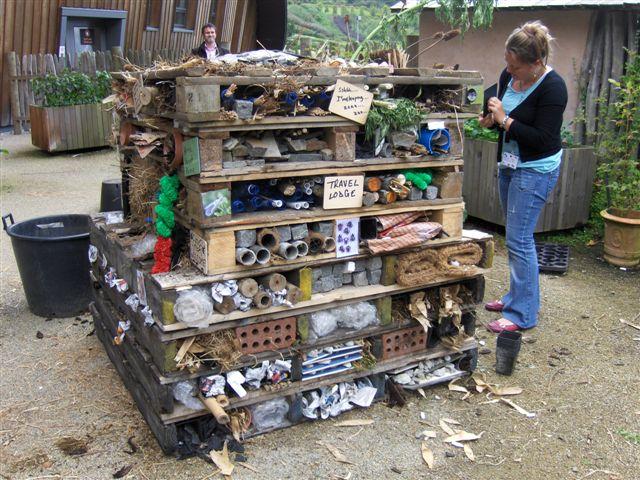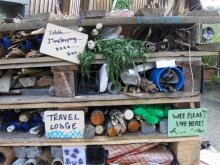Make an insect home
Why not try making your own insect home – or ‘hotel’ – out of junk, to give bugs somewhere to live over the cold months?

Winter’s a good time to do something for wildlife in your allotment or garden. The bugs you offer a home to will repay you in spring when they help control pests and even pollinate your plants.
What you need
You can get creative with these insect homes, as there are no rules. We’ve even got a hot water bottle, an old jumper and a pair of shoes in ours! Here are a few things you might like to use:
Recycled stuff
- Wooden pallets (These are essential - try asking at industrial sites and builders’ yards for free pallets.)
- Plastic bottles
- Broken bricks and tiles
- Stone chippings
- Broken plant pots
- Corrugated cardboard
- Drainpipes
Natural materials
- Logs and twigs
- Rotting wood
- Spare rolls of turf
- Dry leaves
- Bark
- Hollow plant stems
- Straw and hay
- Bamboo canes
How to build your insect home
- Choose a good spot for your insect home. Firstly, because most insects like cool, moist conditions, so a shady area next to a hedge or under the tree works well. Secondly, make sure the home has a firm base, because it will end up quite heavy. Thirdly, choose a spot where the insect home can remain for at least this winter.
- Create a structure with pallets. Layer old pallets on top of each other as tall as you’d like the insect home to be – ours are around eight pallets high, but five will do. Place any larger pallets at the bottom. Check the pallets don’t wobble; secure each to the one below (with string, wire or pull ties) if you need to.
- Fill in the gaps with other materials. There are no rules as to how you fill the empty pallets, but here are some ideas to attract different insects:
Dead wood makes a great home for wood-boring beetles, such as the majestic stag beetle, and their larvae. It also supports fungi, which can break down the natural material. Centipedes and woodlice can burrow under the bark.
Hollow stems, canes, and holes drilled into blocks of wood are all ideal spots for solitary bees to lay their eggs. These bees help pollinate flowers (so helping your plants produce vegetables) in the garden. Because solitary bees like sunny spots, place these on the sunniest side of the insect home.
Stone and tiles provide lovely cool, moist conditions for frogs and newts. They might be best lower down, on the shadiest side of the insect home.
Hay and straw give insects a good place to burrow and hibernate.
Dry leaves provide homes for insects, just like leaf litter on the forest floor. Ladybirds hibernate here over winter – and they're great for eating aphids in the garden.
Rotting wood and bark is where beetles, centipedes, spiders and woodlice love to be. Because woodlice and millipedes break down woody plant material, they’re an important part of your garden recycling system.
Corrugated cardboard rolled up inside a lemonade bottle will attract lacewings, which are really good at eating pests.
Tips on how to make an insect home with your community group
- Discuss the best place for the insect home, taking into consideration forthcoming plans for the shared space.
- Source pallets before you start, but then suggest that everyone brings their own junk and recycled materials to the session; give them guidelines on what sort of thing works.
- Arrange a tidy up of your plot, so that you can use natural materials like stems and leaves.
- Get a few stronger members of the team to put the pallets and heavy items in place, then invite everyone else, including kids, to stuff the other materials into the holes.
- Come and visit the insect homes at the Eden Project for inspiration; they’re next to our big ‘Hive’ building at the centre of the site.

